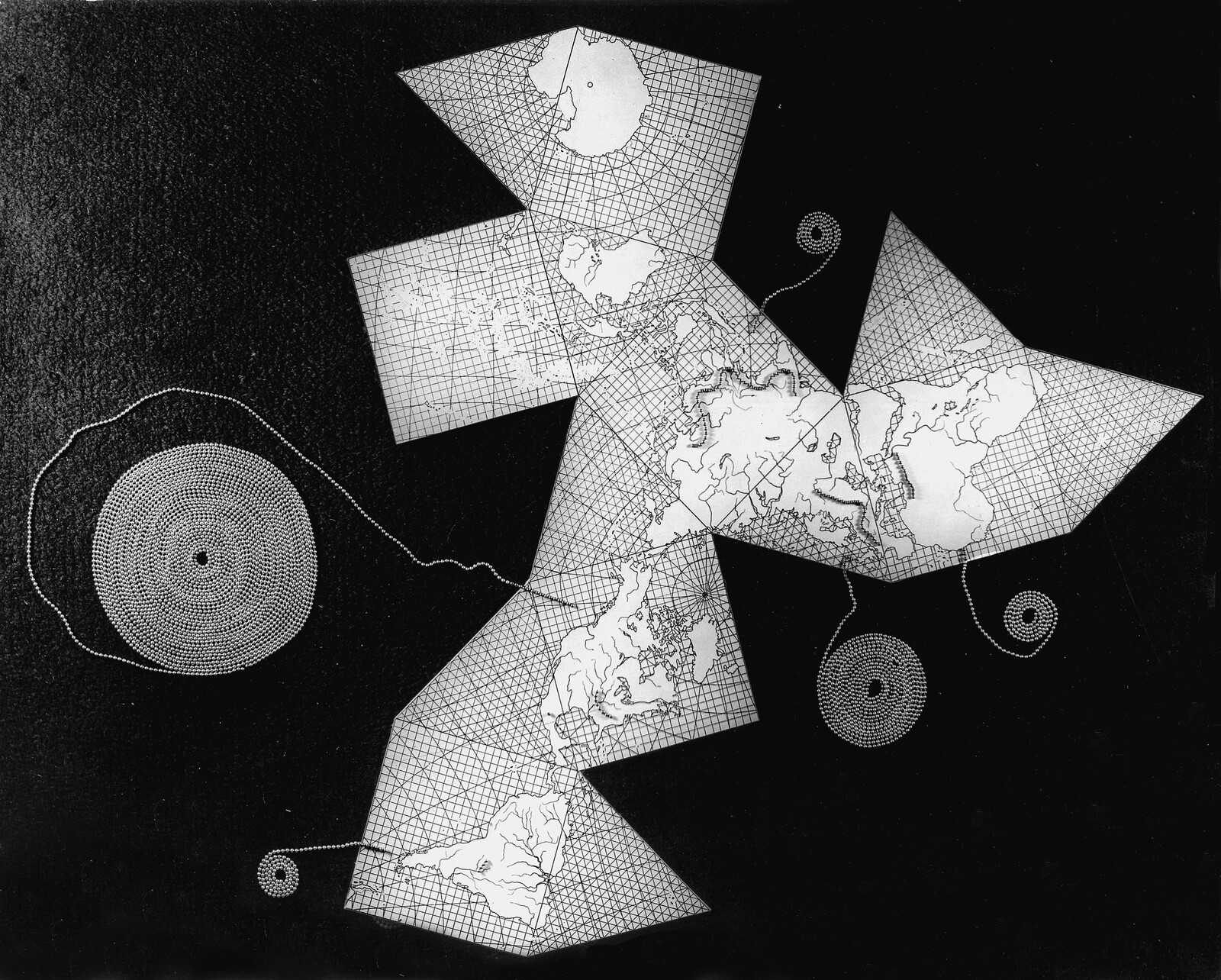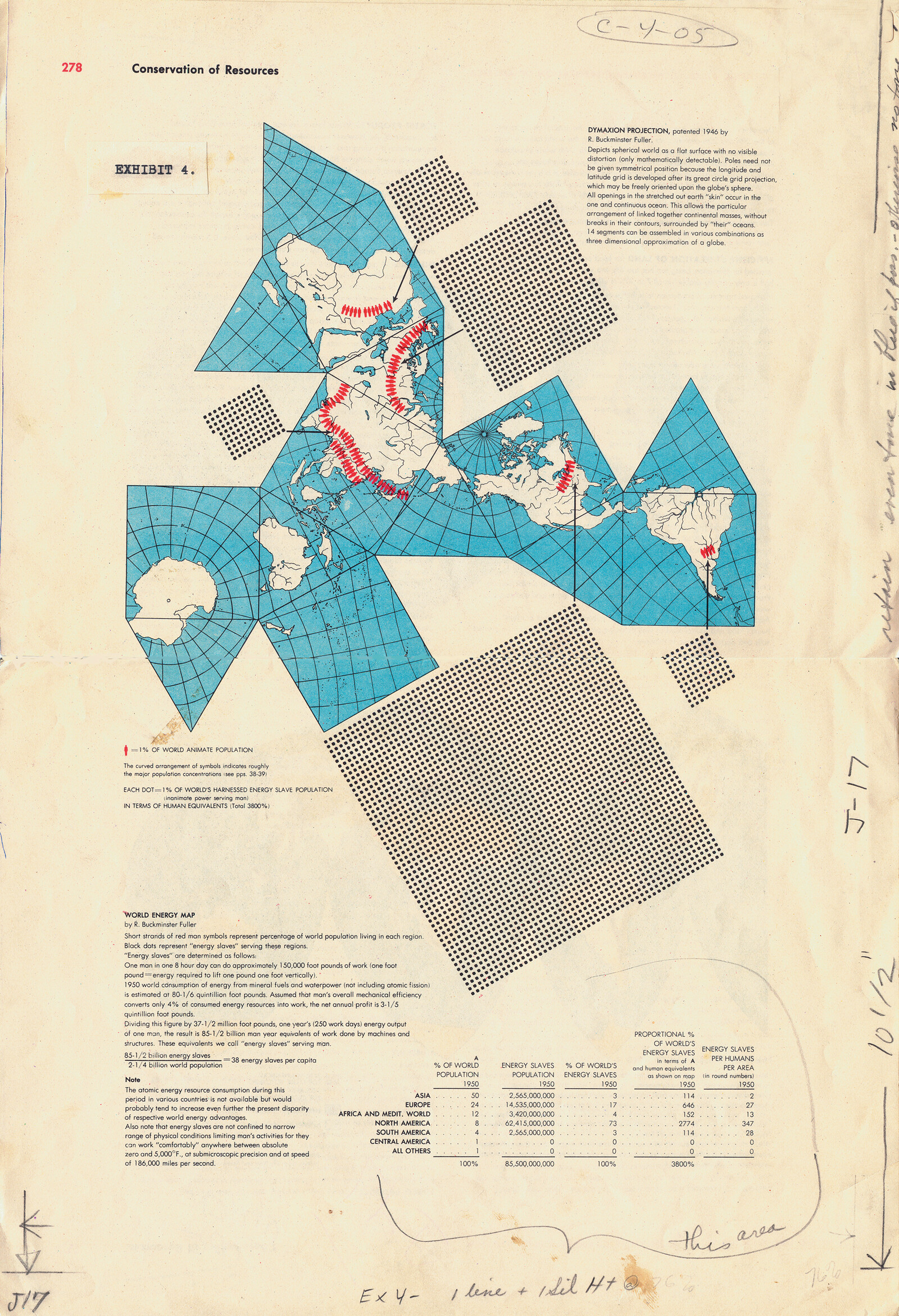During the 1940s, Buckminster Fuller produced a number of maps of the earth with the title or caption “world energy” and “energy slave.” Produced as designs for his “4-dimensional geometric” or “Dymaxion” practice, these cartographies focus on his research into rational predictions of global energy production and consumption in advanced industrialized societies. In each map, Fuller populates the Dymaxion projection of continents with a metaphorical “figure” (beads, dots or human silhouettes) to represent the global distribution of energy required for meeting actual and predicted demands for industrialized energy in the mid-twentieth century. Some of these maps, especially “Conservation of resources” and its various reprints, are accompanied by statistical calculations of this energy distribution and consumption. When considered alongside Fuller’s correspondence with other influential cultural institutions and cybernetic researchers of this period, such as Time Inc. and Marshall McLuhan, these planetary forecasts highlight the intense historical climate of political and energy insecurity before, during, and after World War II. As such, they are scientific and rational visualizations which encode twentieth-century US ideological and socio-economic anxieties about sustaining “peaceful,” “free” and profitable global markets.
A universal and technoscientific language of human and mechanized (nonhuman) labor underpins Fuller’s energy slave maps. Each map’s rational and visual calculations of energy allocation simultaneously manifest the historical tensions of the time in which they were produced, and retain the tensions of present-day concern about global environmental resources. Generated during a heightened period of Western and US state ideological anxiety about national and global security, and underpinned by the desire to defend and secure stable, international markets for US corporations, Fuller’s “sociological” aesthetics—that is, models of technoscientific freedom—operate through a vocabulary composed of economic and mathematic rationalization, geometric universality, and predictions of energy efficiency.
Given our contemporary socio-political concern with the ethics of modelling “data” or “information,” the impact of fossil fuel extraction and carbon emissions on local and global communities, and the issues of labor, trade and markets—which extend from automation to the continuation of slavery—Fuller’s “slave maps” are complex forms of architectural modelling which have historical significance in their own right, and a strong resonance with contemporary debates.
“Untitled” (no date) and “Conservation of resources” (1953) show two of the visual vocabularies that Fuller used to represent units of energy. In the first black and white map, which is untitled and undated, and which may have been made for Fuller by one of his collaborators, the units of energy are represented in a physical three-dimensional collage material. Five separate coils of a beaded metal chain are laid on to the Dymaxion projection, with the end of each coil placed close to a different continent. The smallest coil extends from the Indian ocean; the next coil is by the horn of South America; the third is by the coast of west Africa; the fourth above the UK, and the final, substantially larger coil, extends from the west coast of North America. Three fragments of the chain are also placed on to the map: from west to eastern Europe and up to Moscow; across the north African coast, through Libya and Egypt; and from Pakistan, through India and Asia, up to China (Beijing). Although the map’s caption, “World: Energy slaves Energy slaves/capita human population” is not completely explanatory, it seems reasonable to suggest that each “bead” of the chain represents a unit of energy, or what Fuller called an “energy slave.” In the second map, “Conservation of resources,” a recognizably “human” figuration is used to signify an “energy slave.”1 Although Fuller intended this “figure” to stand in for machinic labor, given that modern US and European industrialized nations are constituted through colonial and racial histories of slavery, this intentionally close imbrication between human slaves and machinic energy is disturbing.
Each map projects a global image of societal “progress” from a US/Western perspective, and consequently, can be read as geopolitical visualizations of the production, distribution, and access to energy resources. Each figure of energy is a rational economic and sociological unit of “life” and “non-life.” Combined with the universal mapping of human and nonhuman forms of energy, these are then, literally, architectural bodies of knowledge. They are figures which continue, rather than disrupt, the modern desire that rational socioeconomic analyses of industrialized energy can be addressed through the neutral autonomy of scientific data or facts. But of course, such universal logics are blind to the significance of the colonial and racial histories of slavery for industrialization.
The maps are also historical precursors which resonate deeply with contemporary political concerns about climate change and the attendant debates about rational powers of forecast that are used by different ecological, political, and economic interest groups. In environmental and climate change debates, forecasting is a major site of disagreement in the contested ideological and agnotological intersections between the scientific community’s “skeptical” methods of knowledge formation, based upon repeated tests of evidential probability, versus the skepticism of climate change in corporations and governments, who seek to protect fossil fuel industries. Thus, while Fuller’s forecasts of human and nonhuman energy relations are today considered historical, since they were produced through analogical design methods rather than contemporary digital data models, the maps are nevertheless previews of a contemporary corporate and governmental fascination with the capacity to economically and politically rationalize “living” information for the accumulation of profit.
While Fuller’s planetary vocabulary precedes contemporary critiques of advanced capitalist societies’ reliance upon the industrial extraction and engineering of carbon and fossil fuel resources, his post-war proposals for increasing the efficiency, concentration, and distribution of energy technologies highlight the intensive ideological and political focus of the time to accelerate carbon-based energy provision. These maps are therefore also striking previews of the globally unequal distribution of human and technologically-assisted forms of life. Although constituting different markets and geopolitical power relations today, the lack of stable environmental, economic, urban, legal, and healthcare security for many in the global south, conflict regions, and even increasingly in developed economies, represents a continuity in the failure of technoscientific utopianism to provide actual and stable global equity—or, in Fuller’s words, “global peace.”
Dymaxion Energetic Geometries
The first of Fuller’s world energy maps was published in the September issue of Fortune in 1940, during the two years when he was employed as a “science and technical” consultant to the magazine.2 The caption for the map explains that technological hubs of machinic energy are represented by red dots, and the different percentages of human population are denoted by white dots. Although the population is higher in Europe, the Indian subcontinent, and China, we can see that the energy consumption in North America is greater than all these other regions combined. This uneven distribution of energy consumption again indicates to Fuller’s interest in the power of maps as cartographic instruments for rationally calculating the human and nonhuman (machinic) values of twentieth-century global industrialization; a logic which naturalizes historic geopolitical inequalities in capitalist energy provision. Moreover, as well as rationally accounting for the higher distribution of the “energy slaves” required for the industrialized north, and the emerging new economies of China and India, Fuller’s “single” world vision previews the continuation of these inequalities into the late twentieth and twenty-first centuries: the map confirms a natural modernist geopolitical “order” of economic and political powers, weighted in favor of the industrialized global north versus the lack of viable and secure energy provision in the global south.
The world energy maps also link back to Fuller’s extensive 4D Energetic Geometry design method, which he established in the 1920s, and through which he produced mathematical, engineering, sociological, architectural and product-design research, including the 4D house “Machine-for-Living” (1928). Patented for Fuller in 1929 by Waldo Warren the advertising specialist from the Marshall Field organization, the term “Dymaxion” was a synthesis of the words, “dynamism,” “maximum,” and “ions,” and codified the universal and rational singularity of Fuller’s practice.
In his late 1973 monograph, The Dymaxion World of Buckminster Fuller, Fuller and his co-author, Robert Marks, explain the logic of this thinking for the cartographic projections that envision the planet’s entire landmass as a single “unified” island within one ocean. Criticizing the spatial distortion of the continents in the Mercator and Robinson projections, Fuller considered these projection systems to be flawed because they were determined by a logic which was “inherently disassociated, remote, self-interestedly preoccupied with the political concept of its got to be you or me; there is not enough for both.”3 Instead, he argued that the Dymaxion cartography presented “a precise means for seeing the world from the dynamic and comprehensive viewpoint,” in which global planetary information is “negligibly distorted.” Consequently, Fuller claimed that this unified cartography would enable the improvement in strategic global design and management of resources; from global airline travel to the flight paths of “an intercontinental ballistic missile.”4
Robert Marks highlights the extent to which this focus on “dynamic” cartographic geometries did not just represent Fuller’s interest in promoting a global representation of human populations and their energy needs, but that the maps also constitute environmental visualizations of energy information. He explains that they present the spatiotemporal geometric organization of other species, for example, in the “major and minor ecological patterning” of different regional and scales of geometric order seen in of bird nest-building and bird migration journeys.5 The view that Fuller’s designs are valuable, dynamic geometric forms of “ecological” information is still apparent in architectural education today, especially for those professionals who use computation to envision environmental, social, and spatial information: for example, the use of “flocking” and “swarming” metaphors to describe the different scales and complexity of group and individual organization and interaction. However, as recent architectural historians and theorists have also shown, Fuller’s universal mappings of human and nonhuman energy are also inherently biopolitical concerns. His technoscientific design logic is imbricated with the forecasts of societal, environmental and planetary relations that the US government and its affiliated institutions and corporations promoted at the time.
Fuller’s world energy map, “Conservation of resources,” is a particularly strong example of how different kinds of human life can be deemed life and non-life, depending upon one’s racial, social, historical and political position. Published at a time when US concern about the impact of Soviet ideology on the long-term global security of energy resources was still raised, the map’s graphic, geometric, and numerical figures show the inequality of distribution between “free” and advanced industrialized (i.e. “automated”) populations, and the “enslaved” populations of non-industrialized continents. Despite his humanitarian vision, Fuller’s commitment to a universal dynamic cartography of life and energy contains within it the power to dehumanize lives. Given the colonial history of modernity, this often means communities that have been politically and historically enslaved because of their racial difference, and whose status of “non-life” is increased by their interchangeability with units of mechanized energy.
Fuller’s use of the term “energy slave” to define a unit of mechanical energy is central to this map’s predictive powers of quantifying and distributing post-war global mechanical energy, which forecasts that the US will require 347 mechanized/ nonhuman energy-producing units to support the standard American household in 1950. The caption below the map show Fuller’s calculations that the mechanized energy needed by the US is 2774% of the total energy slaves then globally available. In contrast, South America will require 114% of the world’s energy slave allocation, 646% by Europe, 152% by Africa and the Mediterranean, and zero by Central America.
In addition to these predictions, which naturalize the US as the major recipient of automated power (and by implication, its capacity for providing democratic freedom), another unsettling element in this map is the literal figuration of nonhuman automation in the repeated identical image of a human figure. Given advanced capitalist societies’ historical formation through colonialism and slavery, these silhouettes—especially when they are black, as in the 1973 reprint—reinforce the historical connection between laboring bodies and enslavement. Yet Fuller’s utopic calculations of mechanized labor, as a means for securing global post-war energy needs, rationally neutralizes fundamental biological and political inequalities and violence in the colonial history of the West.
Fuller’s technological rationalism for explaining complex questions of life and energy needs is visible in his calculation of the amount of energy that an energy slave accounts for. He calculates that, in 1950, 38 energy slaves are required per person: a figure which is achieved by dividing the total number of energy slaves required by the total world population at the time (85.5 billion energy slaves divided by 2.25 billion people). Both a mathematical and statistical operation, this is a logic that rationally connects, and distinguishes between, the different values attributed to human and nonhuman forms of life (human versus automated energy). Moreover, Fuller’s conjunction of technoscientific and sociological terminology in the term “energy slave” constitutes a kind of naturalization of this unequal power relation. In their 1973 commentary about the term, Fuller and Marks reveal how the history of slavery is naturalized into a technoscientific narrative, when they write that Fuller considered energy slaves to be “natural saviors of society” because they represent “man’s potential control over [the] environment [as] approximately unlimited.”6 Ironically, while trying to acknowledge the history of slavery in the US, they in fact show these designs to naturalize colonialism: for example, in proposing that the term “energy slave” retrieves the forgotten value of the enslaved in America’s history as the “genii of industrialization.” Rather than humanizing those people who were enslaved, this language of symbolic production serves to further alienate these individuals to the status of “other” or “nonhuman.” Slavery is first naturalized and then, in the sentences that follow, discounted, when Fuller concludes that twentieth-century US, global, and Soviet progress is actually the result of technoscientific progress, rather than political democracy. Such calculations of equivalence between nonhuman slave life and automated machines therefore show how “natural” logics of similarity or interchangeability constitute an exemplary biopolitical form of management of “life” and energy.
Fortune culture
Fuller’s energetic promotion of technoscientific forecasts are also closely affiliated with the economic and political interests of powerful US cultural institutions at the time, including Fortune magazine, and highlight the extent to which his thinking was consistent with mid twentieth-century national ideology. Internal memos from the magazine show the febrile language used to promote “progressive” US economic and technological security during the period. For example, in his June 1940 editorial memo on “some fundamentals concerning FORTUNE’s approach to the present-day,” the magazine’s publisher, Eric Hodgins, instructed his staff “to reflect the seriousness of the international crisis” by rejecting stories that were concerned with “Luxury” or “Chatter,” “for a good long while to come.”7
Focusing on the specific “editorio-diplomatic situation” of the period, Hodgins’ memo asks his staff to write articles about “work” rather than “Sociological talk” of “new models of perfect society.” “Every story needs, for its being, the sharpest reason of production, management, distribution, technology, resource or strategy.” The memo ends pugnaciously: “We should continue to be a magazine of libertarian economics. We can and should still campaign for technological progress, and the minimum deterioration of our standard of living consistent with a united effort at national defense.” As such, the editorial reveals how Time Inc., Fortune’s parent company, saw the magazine’s journalism as both “investigative” and in line with US scientific, economic, and nationalist ideologies of freedom. Any information or tone of voice considered to be destabilizing, unscientific, or unpatriotic was explicitly designed out of the magazine’s content during this period.
We also see this desire to separate scientific methods and findings (i.e. progressive “truths”) from the threat of ideological uncertainty in Fuller’s belief that science could be delimited from fascist and communist histories. In August 1940, in an exchange of memos with a Time Inc. colleague about the historical valences of the term “rationalization,” Fuller insists that US-produced scientific data has an autonomy and authority that originates from classical thought, distinct from the ideological contamination of fascism. He strongly rejects the suggestion made by editorial assistant, Ruth Berrion, that rationalization has associations with 1920s German economic, financial, and technological forms of organization. In his lengthy reply to Berrion, he writes the following complaint:
[The author of this text] does not say, as a scientist would if that were his intent, “popularly known as rationalization.” … My irritation on this score springs from the many degradations of scientifically evolved words, toward similar careless ends. One feels that possibly such etemological [sic.] perversion is the first step towards ultimate perversion of science to progress by destruction. For instance, there is the word “efficiency,” a technical essential … By depriving of the word “efficiency” of its full unprejudiced scientific connotation, they have, so to speak, put holes in man’s car-blades.8
Later, in an exchange of letters with Marshall McLuhan in 1963, there is also an affinity between Fuller’s technoscientific planning and McLuhan’s 1960s cybernetic rationalization of information. Following a meeting with Fuller, McLuhan’s letter considers the roles of “information process” technologies (e.g. publishing, broadcast media, and film), and observes “the problem of estimating the quantities and ratios of information activity and movement in the world today.”9 He asks Fuller to suggest “a comprehensive strategy for tackling a statistical quantification … of information process.” In the following sentence, the link between his and Fuller’s rationalization ambitions is even clearer: “You know well how automation is an information process. Does this not mean that the future work of mankind must be learning?” McLuhan’s letter defines his cybernetic theory as ecological, in a manner very similar to Fuller’s book published in the preceding year, Education Automation.“As you know, I make bold to suggest that we may be very close indeed, to a technological extension of consciousness. Consciousness is a process constituted by ratio among the senses. The whole ecological idea of our time is, in effect, an extension of consciousness, however tentative.”10
Fuller’s reply to McLuhan, sent with a copy of Education Automation, agrees that education is “by far the greatest industry of tomorrow.” But, rather than fully endorsing the science of cybernetics, he maintains that mathematics is at the core of progressive (and by implication, democratic) knowledge: “consciousness has always been extended by mathematics.” Given the value of contemporary biometric data for expanding the financialization of the global higher education market (and the value of these markets for the platform technology companies, including Facebook and Google), this exchange previews the extent to which technological, sociological, and architectural design research of this period was infused with utopian ideas about the potential to manage and improve “life” on many biological and political levels (and what Fuller himself sometimes called “livingry”).
In an earlier forecast of world industrialization from 1952, Fuller’s modelling of the interaction between global populations and automation is much less optimistic. The potential for progress and “peace” to be achieved through automation is threatened by the risks posed from social and economic inequality and political conflict. Beginning at the year 1900 and continuing until 2000, the graph predicts the increasing rate of automation, i.e. the implementation of “energy slave” units, per year. 1952 is at the mid-point of acceleration. Higher up on the curve, Fuller indicates that 1972 is the “critical point” when “50% automation” will be reached. From this point, he calculates two different speeds of automation, one which achieves 100% automation in 2000, and a second, faster rate of automation, that is achieved in (approximately) 1983. At the top left of the graph, Fuller describes world industrialization as:
the rate of attainment as an industrially objective advantage to individuals. i.e. when 100 inanimate energy slaves are in continual active service per each and every family existing in governing economy and those energy slaves are primarily focused upon regeneratively advancing standards of living and in articulating amplifying degrees of intellectual and physical freedoms.
The immediate twenty-year period ahead of when the graph was made, from 1952 to 1972, is also central to the forecast, and is defined as a time of “imminent global crisis for all men.” However, the graph also predicts that this geopolitical instability in “world peace” will be averted by the 50% tipping point in 1972. This date, Fuller suggests, is when “the restless ‘have nots’” will be converted into the peaceable “haves.” The caption states: “Until critical point is reached majority of world men are ‘have nots’ and are incitable to socialism by revolution against the seemingly ever more unduly privileged minority after 1972 majority are haves.”
1972 is of course also significant as the year in which Donella and Dennis Meadows, Jordan Randers, and William Behrens published Limits to Growth: A Report for the Club of Rome’s Project on the Predicament of Mankind, which warned that even the most optimistic predictions of technologically-advanced global economic and population growth could not be achieved. Thus, when reproduced in the 1973 monograph—one year after Fuller’s predicted “tipping point”—the graph is a strikingly utopian prediction that global economic efficiency, energy production, and hence, “civilized” or “peaceful” forms of society, are best met through technocratic means.
Given current discussions about whether automation—the “fourth industrial revolution”—will bring any real improvement in social, political, economic, or environmental equity to those individuals and communities who are still laboring in dehumanizing markets (i.e. women of color, migrant and precarious workers, people in low-paid or exploitative industries), Fuller’s belief in the predictive power of technoscience for social and economic progress is more pertinent than just representing a historical point of interest to architects. Also, given that slavery still persists in the trafficking of living (but often also, tragically, near-dead) bodies, it is clear that issues of human and nonhuman (i.e. slavery) energy are tied up in many global migration and refugee movements of people, especially from conflict zones and regions where there is high food, health, economic, and environmental insecurity.
Fuller’s energy slave and world energy maps, and his associated writings, are consistent with the political ideals of twentieth and twenty-first century advanced and emerging capitalist societies and economies in which forecasts of sociological information are seen as important design tools for tackling issues of energy distribution and complex socio-economic needs. But in the shift from the utopian post-war era of unfettered acceleration to the tipping point of growth predictions in 1972 and our contemporary global environmental crisis, it is clear that planetary projections—by architects and other researchers (especially state-funded, private, and corporate think-tanks and research institutes who work with digital “platforms” and “infrastructural” finance)—must be based upon critical understandings of the existing structural inequalities in the economic governance, management, and technologies of energy production. It is only with such a perspective that models which ethically and concretely contribute towards improving political, social, environmental and economic equity might be created.
Fuller’s map is printed in the final section of Bayer’s book in a section also titled “Conservation of resources.” Peder Anker observes that the human figures in this map are a feature of Herbert Bayer’s design graphics in this publication (see Peder Anker, “Graphic Language: Herbert Bayer’s Environmental Design,” Environmental History 12 (April 2007): 254–278). However, this synthesis of Bayer’s graphics into Fuller’s map also constitutes a visual language of “energy slaves” which is consistent with Fuller’s humanistic aims. For reproductions of the Dymaxion world map during the 1940s see: “Life presents R. Buckminster Fuller’s Dymaxion World,” Life Magazine, March 1, 1943: 41-55, which begins with the sub-header “It is designed for political geographers.” On the reverse of the cut-out map which could be assembled by readers, Fuller calculates percentages of land, water and populations in the US, Chile, Argentina, the North and South Poles. In 1944 a version of the world map by Fuller and assistants was reproduced in The American Neptune: A Quarterly Journal of Maritime History and Arts IV, no 2 (April 1944): 119–136, accompanying an article by Fuller titled, “Fluid Geography.” The map carries percentages of world population in the continents. In footnote 1 on page 122–123, Fuller outlines his chronology of world maps since 1927.
R. Buckminster Fuller and Robert Marks, The Dymaxion World of Buckminster Fuller (New York: Anchor Press Doubleday, 1973), 21.
➝.
Marks and Fuller, 51.
Marks and Fuller, 16.
Marks and Fuller, 53-54.
Hodgins memo, p.1. Eric Hodgins was Publisher of Fortune Magazine between 1937–41, and during Fuller’s appointment. From 1941–46 he was Vice-President of Time Inc., and in 1946 he published the novel Mr Blandings Builds His Dream House.
Memo from Buckminster Fuller to Ruth Berrion, August 11, 1940, 2.
Letter from Marshall McLuhan to Buckminster Fuller, 11 August, 1963.
Ibid.
Structural Instability is a collaboration between e-flux Architecture and PennDesign.
Category
Subject
All images and quotations from correspondence are reproduced Courtesy, R. Buckminster Fuller Estate.
Structural Instability is collaboration between e-flux Architecture and PennDesign.
















